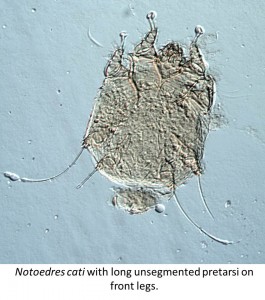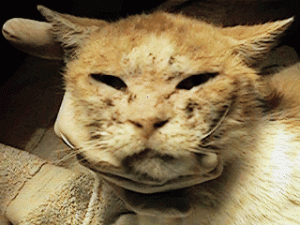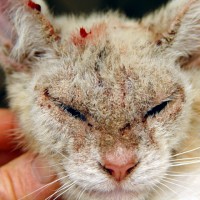Cat Mange is a skin disease caused by various tiny mite species. Some of the causative mange mites are normal residents of your cat’s skin and hair follicles while others are considered parasites. The skin infection ranges from mild to severe depending on how the mites proliferate. This post/article provides insight into the causes of Cat Mange (Feline Scabies), symptoms, treatment, prevention and tips. These are key if you’re looking to provide better pet care to your cat.
Causes and Symptoms
Causes of Cat Mange (Feline Scabies)
 Cat Mange (Feline Scabies) is also sometimes referred to as Notoedric mange due to the fact that its similar to the sarcoptic mange which affects dogs. It’s caused by Notoedres cati. The small microscopic monsters normally attach to your cat’s skin where they burrow after mating.
Cat Mange (Feline Scabies) is also sometimes referred to as Notoedric mange due to the fact that its similar to the sarcoptic mange which affects dogs. It’s caused by Notoedres cati. The small microscopic monsters normally attach to your cat’s skin where they burrow after mating.
The mites are associated with severe skin infections in cats starting on the face and ears and spreading to the entire body. The nasty bugs are contagious and can spread from cats to dogs or humans. While older cats may contract Cat Mange (Feline Scabies), kittens are at a greater risk to contact the condition.
Symptoms
Cat Mange tends to be either localized or affecting specified areas of the cat’s body. In the early stages, the localized form of mange exhibits change in the behavior of your pet. This is due to the fact that the cat tends to be itchy. The cat tends to scratch a lot. The patches she scratches usually develop some red papules which resemble small pimples. However, the pimples eventually crust after some time.
In time, the affected skin will become both wrinkled and thickened. These cat mange symptoms are due to an allergy associated to the mite itself. Restlessness, intense itching and frantic scratching are some of the symptoms exhibited in the first week of exposure. This leads to hair loss and a moth-eaten appearance to the cat’s skin.
Some of the commonly affected areas include your cat’s ears and face though it has the potential to spread to the entire body. In this case, your cat’s hair may become matted; crusted sores are visible on the cat’s forelegs, paws, and lower stomach. This itchiness tends to intensify, making the cat very uncomfortable. With intense scratching, the wounds become infected.
Treatment of Cat Mange
Prior to any treatment, your vet will perform proper diagnosis to ascertain for a fact that your cat has been affected by Cat Mange.
In diagnosis, your veterinarian will carry out a thorough physical examination of your cat, and ask various question about your pets recent behavior. Your vet will also collect skin scrapings from the affected areas. The samples will be tested to evaluate the presence of Scabies. The veterinarian may also recommend other tests which are specific to your cat’s symptoms . It is only through proper and timely diagnosis that the situation can be treated before it becomes mild or chronic.
The treatment of mange is usually variant based on your cat’s the level of infection and the cat’s particular situation. If detected, the first step in the treatment of mange includes isolating your cat.
Getting Rid of the Mites
Isolation prevents the situation (which is highly contagious) from affecting other pets and humans. The treatment however, typically includes the use of specialized shampoos and dips. Area that you cat frequent will need to be thoroughly cleaned. Regular vacuuming coupled with cleaning of your cat’s bedding is also a suitable recipe to getting rid of the mites.
In the event where secondary bacterial infection is present, additional medications including antibiotics may be prescribed.
Vet treatment options
The vet will first prescribe the best medication to kill the mites. Based on the type of mange and your cat, this medication can be applied both topically, through injection, or by shampooing and dipping. Your vet may also prescribe antibacterial shampoo; anti-inflamatories and antibiotics which will help treat skin issues and ease inflammation.
Note: that although mites are killed quickly, the results usually take time and are only seen after months of treatment.
Do It Yourself (DIY)
 While vet services exist, you may sometime choose to treat Cat Mange (Feline Scabies) infestation on your own. In such cases, it is vital to know some of the key aspects to observe during a DIY treatment. The scabies affected areas on long haired cats may need to be clipped and the entire animal bathed in warm water and soap. This helps to loosen the crusts. The kittens may also be dipped or shampooed. However, they must be dried quickly to prevent them from getting to cold.
While vet services exist, you may sometime choose to treat Cat Mange (Feline Scabies) infestation on your own. In such cases, it is vital to know some of the key aspects to observe during a DIY treatment. The scabies affected areas on long haired cats may need to be clipped and the entire animal bathed in warm water and soap. This helps to loosen the crusts. The kittens may also be dipped or shampooed. However, they must be dried quickly to prevent them from getting to cold.
Dipping the cat in 2.5% lime sulfur weekly helps in killing the head mites. This treatment should be continued for a duration of two weeks after the apparent cure to effectively eliminate the skin infestation. The lime sulfur dips are safe and can even be used on pregnant cats and kittens with an age of over 6 weeks. Other cats on your premises should also be dipped once a week for 3-4 weeks as they may also harbor the Cat Mange causing mites which could act as a reservoir for re-infestation.
Selamectin (Revolution) is an alternative to dips and has doses which are given once a month (but please contact you vet before use). Ivermectin is also recommended by some veterinarians.
Prevention and Tips
The best preventive care for Feline Scabies is to ensure that you separate your animals as soon as you notice infection. This is because mites need direct contact to pass infection as they cannot survive for long in the environment. If your cat has been diagnosed with mange, you need to thoroughly clean and replace the beddings, dishes, collar and toys. If you suspect that your neighbor’s cat may be infected, make sure you keep your pets away. This helps to keep the disease at bay.
It is also advisable to bring your cat to the vet as directed. This ensures that appropriate care is provided and mites eradicated if present. Ensure that you take your cat to the vet to ascertain the presence of the situation. More so, certain cats are prone to mange than others. Ensure that your cat is well nourished and its immune system is not compromised.
Thanks for The Cat Dandruff Clinic, if you found this article informative please like us using the side bar .



Comments are closed.